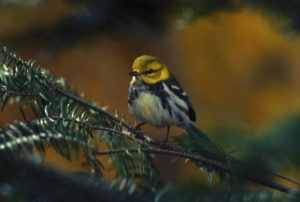By Jessica Johnsrud, Woodland Dunes Education Coordinator
This sure is an exciting time of year! It seems like each day, a new plant is emerging, a different frog is singing or a new species  of migrant songbird has returned from its wintering grounds. In the last couple of days, I have seen my first black-throated green warbler, Nashville warbler and chimney swifts of the year. Other birdwatchers in the area have seen their first orioles, grosbeaks and even hummingbirds. These daily arrivals are little surprises and remind us that birds and nature aren’t in quarantine.
of migrant songbird has returned from its wintering grounds. In the last couple of days, I have seen my first black-throated green warbler, Nashville warbler and chimney swifts of the year. Other birdwatchers in the area have seen their first orioles, grosbeaks and even hummingbirds. These daily arrivals are little surprises and remind us that birds and nature aren’t in quarantine.
Traditionally, Woodland Dunes hosts its annual Bird Breakfast and Migration Celebration in May. This event invites the community to a ham and pancake breakfast and celebrates the return of migratory birds through guided bird hikes and activities. This event also coincides with World Migratory Bird Day (WMBD), which is an awareness campaign highlighting the importance for conservation of migratory birds and their habitat. It also draws attention to the need for international cooperation to conserve migratory flyways because birds do not recognize borders. Each year, a theme is selected for WMBD and this year’s theme could not be more appropriate, “Birds Connect Our World.”
Birds do connect our world. The black-throated green warbler I mentioned earlier is a tiny, insect-eating bird that spent the winter in Central America. This spring, it flew thousands of miles through Central America, the southern United States, Wisconsin and is continuing it’s migration to the northern conifer forests where it will nest. This little bird will stop in forests and green spaces several times along the way to rest and refuel. Just think of all the people that may have observed the black-throated green warbler flitting about in trees and shrubs hunting insects? Or heard it’s distinct “trees, trees, murmuring trees” call?
Birds also connect our world through scientific research. Scientists around the world use various tracking technologies to understand the routes migratory birds use, how long birds live and other health status information. Some scientists band birds with a metal band with a unique identification code, which helps identify the bird if it is recaptured again. Others use global positioning systems (GPS) tags by attaching a receiver to a bird, which receives signals from satellites that are orbiting the Earth. Data from these technologies is shared and used to inform international conservation efforts.
There are several other methods of studying birds, but there’s one that everyone can take part in: sharing bird observations. People can record their bird observations online through eBird or iNaturalist or take part in citizen monitoring projects such as the Midwest Crane Count, Backyard Bird Count and several others.
The Bird Breakfast event has been canceled this year due to the pandemic. Even though we can’t be together physically, Woodland Dunes is still celebrating Bird Breakfast and World Migratory Bird Day and invites you to do the same! Watch our Facebook page for posts about bird behavior, feeding birds, family activities and more! Posts will begin Sunday, May 10th and continue through the week. Birds truly connect our world and we can still connect virtually to share the common bond of birdwatching and caring for nature.
photo of Black-throated green warbler
